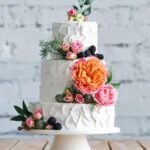Timing is everything when it comes to cake decoration. Whether you’re preparing for a special occasion or simply indulging your artistic flair, knowing how far in advance you can decorate a cake is crucial. The key lies in finding the perfect balance between ensuring the decorations stay fresh and vibrant while also allowing enough time to complete intricate designs.
In this article, we will explore the factors that determine how far in advance you can decorate a cake. From the type of icing used to the complexity of the design and the intended serving time, each element plays a significant role in determining the optimal timing. We will delve into specific considerations for both buttercream and fondant cakes, providing insights on preventing icing from melting or drying out as well as managing humidity levels.
Additionally, we will discuss when different decorative elements should be added to maximize their impact. Whether it’s gum paste flowers, intricate piping, or edible toppers, each element requires careful timing for best results. We will also explore storage options for decorated cakes, including refrigeration and freezing techniques.
Proper time management is crucial in cake decoration. We will share practical tips and strategies for effective time management when decorating cakes – creating timelines, prioritizing tasks, and utilizing time-saving techniques. Case studies featuring professional cake decorators will provide real-life examples of successful advanced decorating practices.
So join us on this journey as we navigate the world of cake decoration timing and discover just how far in advance you can create stunning masterpieces that leave your guests in awe.
Understanding the Factors
Timing is a crucial aspect of cake decoration, and it is important to consider several factors when determining how far in advance a cake can be decorated. These factors include the type of icing used, the complexity of the design, and the intended serving time. By understanding these factors, cake decorators can ensure that their creations are visually stunning and delicious when it’s time to serve them.
Type of Icing
The type of icing used on a cake plays a significant role in determining how far in advance it can be decorated. Buttercream icing is versatile and can typically be applied a few days in advance without any issues. However, it’s essential to properly store buttercream cakes by keeping them at room temperature or refrigerating them if necessary.
On the other hand, fondant icing requires more attention to timing. Fondant-covered cakes should ideally be decorated on the day they will be served or one day prior. This is because fondant tends to lose its freshness over time and may start to sag or develop cracks. To ensure optimum results with fondant cakes, it is best to decorate them as close as possible to the event or occasion.
Complexity of Design
The complexity of the decoration also affects how far ahead a cake can be decorated. Intricate designs that involve delicate details such as gum paste flowers or intricate piping should typically be added closer to the serving time. This is because these types of decorations are more susceptible to becoming damaged during storage or transportation.
However, simpler designs like basic buttercream borders or simple fondant shapes can be added earlier without compromising their appearance. It’s important to plan ahead and determine which elements of the design need to be added last-minute, allowing sufficient time for those components while still ensuring that other decorations remain intact.
Intended Serving Time
Another critical factor in determining when to decorate a cake is the intended serving time. If the cake needs to be served within a few hours, it is best to decorate it as close to the serving time as possible. This ensures that the icing remains fresh and that any delicate decorations do not wilt or lose their shape.
However, if the cake will be served the next day or in a couple of days, decorators have more flexibility in terms of when they can decorate the cake. In such cases, it may even be helpful to allow the decorated cake to sit for some time so that the flavors can meld and develop.
By considering factors such as the type of icing used, complexity of design, and intended serving time, cake decorators can determine how far in advance they should decorate their creations. Proper timing ensures visually appealing cakes that are still fresh and delicious whenever they are ultimately served.
Buttercream Cakes
When it comes to decorating buttercream cakes, timing is crucial. It is important to find the optimal window of time to ensure that the icing doesn’t melt or become too dry. The type of buttercream icing used, the complexity of the design, and the intended serving time are all factors that should be taken into consideration.
To prevent any issues with melting, it is generally recommended to decorate buttercream cakes no more than 1-2 days in advance. However, this can vary depending on the specific recipe and ingredients used in the buttercream icing. If you are using a recipe that contains perishable ingredients such as cream, it is best to err on the side of caution and decorate closer to serving time.
One way to prevent melting is by keeping your cake refrigerated or in a cool environment until it needs to be served. This will help maintain the stability of the buttercream icing. Additionally, if you plan on transporting the cake, consider chilling it for a short period before leaving to minimize any movement or shifting during transit.
Another issue that can arise when decorating buttercream cakes in advance is dryness. Buttercream tends to dry out over time, especially if exposed to air for extended periods. To avoid this, one option is to brush simple syrup onto your cake layers before applying the crumb coat and final layer of buttercream frosting. Simple syrup not only enhances moisture but also extends the shelf life of your cake.
| Issue | Tips |
|---|---|
| Melting | – Decorate no more than 1-2 days in advance\n – Keep cake refrigerated or in a cool environment\n – Chill before transporting |
| Dryness | – Brush simple syrup onto cake layers\n – Apply crumb coat and final layer of buttercream frosting\n – Use an airtight container for storage |
Fondant Cakes
When it comes to decorating fondant cakes, timing is crucial. It is important to plan ahead and consider the specific steps involved in working with fondant. The process of covering a cake with fondant can be time-consuming and requires attention to detail. Additionally, applying intricate designs and decorative elements adds another layer of complexity to the timing.
One key factor to consider when decorating a fondant cake is humidity. Fondant can be quite sensitive to humidity, which can affect its texture and appearance. In humid conditions, fondant tends to absorb moisture from the air and become sticky or even dissolve.
On the other hand, in dry conditions, fondant may become too dry and crack or harden quickly. Therefore, it is essential to take into account the prevailing humidity levels when deciding how far in advance to decorate a fondant cake.
Another aspect to consider is the time needed for the different steps involved in working with fondant. After covering the cake with a layer of buttercream or ganache as a base for smoother icing application, it is recommended to let it set in the refrigerator for at least an hour before applying the fondant.
This allows for easier handling of the cake during the application process. Once covered with fondant, any additional decorations such as intricate designs made from edible sugar paste or gum paste flowers should be added while keeping any time constraints in mind.
To provide some guidance on timing for decorating fondant cakes:
- Covering Cake with Fondant: Ideally done 1-2 days before serving.
- Applying Intricate Designs: Depending on complexity, designs can be applied 1-3 days before serving.
- Effect of Humidity: Adjusting decoration timeline based on humidity levels and prioritizing adding moisture-sensitive elements closer to the serving time.
Keeping the timeline and humidity in mind, it is essential to store fondant cakes properly to ensure their freshness and preserve the integrity of the decorations. Placing a fondant cake in an airtight container and storing it at room temperature in a cool, dry place is recommended. Refrigeration can cause the fondant to sweat or become sticky, while freezing can affect the texture and appearance of the decorations.
By understanding the steps involved in working with fondant, considering the effect of humidity, and proper storage techniques, cake decorators can ensure that their fondant cakes are beautifully decorated and delivered fresh for any occasion.
| Fondant Cake Decoration | Recommended Timing |
|---|---|
| Covering Cake with Fondant | 1-2 days before serving |
| Applying Intricate Designs | 1-3 days before serving (depending on complexity) |
| Effect of Humidity | Adjust decoration timeline based on humidity levels; prioritize moisture-sensitive elements closer to serving time. |
Decorative Elements
When it comes to cake decoration, the timing of adding different decorative elements can greatly impact the overall look and quality of the finished product. From gum paste flowers to intricate piping and edible toppers, knowing when to incorporate these elements is essential for achieving the best results. Here are some guidelines on when to add these decorative elements for optimal outcomes.
- Gum Paste Flowers: Gum paste flowers are often used to add an elegant touch to cakes. These delicate decorations require time and skill to create, so it’s important to plan ahead. Generally, gum paste flowers should be made in advance and allowed ample time to dry completely before being added to the cake.
Depending on the complexity of the design, this process can take anywhere from a few days to a couple of weeks. By allowing enough time for drying, you ensure that the flowers hold their shape without wilting or collapsing on the cake. - Intricate Piping: Intricate piping designs can elevate a cake’s appearance with intricate patterns or personalized messages. For best results, piping should be added as close as possible to the serving time. This prevents any smudging or smearing that could occur while handling or transporting the cake. To save time on decorating day, consider practicing your piping techniques in advance and create templates or stencils that can be easily applied on-site.
- Edible Toppers: Edible toppers like sugar sculptures or fondant figurines can add a whimsical touch or reflect the theme of an event. These decorations should ideally be added just before serving the cake since they tend to soften over time when exposed to moisture in the air or through contact with icing. By waiting until shortly before serving, you ensure these delicate details stay intact and maintain their visual appeal.
By following these guidelines for incorporating different decorative elements into your cake designs, you can achieve professional-looking results and avoid any potential mishaps or disappointments. Remember, planning and timing are key factors in successful cake decoration, so take the time to plan your design, create in advance, and add those finishing touches at the right moment.
Storing Decorated Cakes
Once a cake has been successfully decorated, it’s important to store it properly to maintain its freshness and preserve the integrity of the decorations. There are a few different options for storing decorated cakes, depending on your specific needs and preferences. Two common methods include refrigeration and freezing.
Refrigeration is often the go-to choice for storing decorated cakes in the short term. It can help keep the cake moist and prevent any buttercream or cream cheese frostings from spoiling. However, it’s important to note that certain types of cakes can dry out in the refrigerator if not stored properly. When opting to refrigerate a decorated cake, follow these steps:
- Make sure the cake is completely cooled before placing it in the refrigerator.
- Cover the cake with plastic wrap or place it in an airtight container to prevent it from drying out.
- If using plastic wrap, secure it tightly around the cake to create a seal.
- Avoid storing strongly flavored foods near the cake, as they can transfer their flavors onto it.
Another option for storing decorated cakes is freezing. Freezing allows you to prepare and decorate a cake well in advance of an event while keeping it fresh. However, this method requires careful attention to prevent any damage or loss of quality. Here are some guidelines for freezing decorated cakes:
- Once your cake is fully cooled and decorated, place it in the freezer unwrapped for about 1 hour to allow any moisture on top of icing or decorations to harden.
- After this initial freeze, remove the cake from the freezer and wrap it tightly with plastic wrap followed by aluminum foil or place it inside an airtight container.
- If you have multiple tiers or layers, wrap each one separately before assembling them together with frosting or fondant.
- Label the package with the date of freezing to keep track of how long it has been stored.
- To thaw the cake, remove it from the freezer and let it defrost in the refrigerator overnight. Avoid unwrapping or touching the cake until it reaches room temperature to prevent any condensation from forming on the decorations.
By following these guidelines for refrigeration and freezing, you can ensure that your decorated cakes remain fresh and visually appealing for longer periods of time. However, it’s important to note that not all types of cakes or decorations are suitable for refrigeration or freezing. It’s always a good idea to consult with a professional cake decorator or refer to specific recipes and instructions for best results.
Tips for Time Management
Create a Timeline
One of the key strategies for effective time management when decorating a cake is to create a timeline. This involves breaking down the entire process into smaller tasks and assigning specific deadlines for each task.
Start by determining the serving time or event date, and then work backwards to allocate time for each step, such as baking, cooling, crumb coating, icing, and adding final decorations. Having a clear timeline will help you stay organized and ensure that you have enough time to complete each task without feeling rushed.
Prioritize Tasks
Another important tip for time management in cake decorating is to prioritize tasks based on their importance and complexity. Start with the tasks that cannot be done in advance, such as applying fresh flowers or adding delicate details.
Once these tasks are completed, move on to the ones that can be done ahead of time, such as making gum paste flowers or preparing decorative elements. By prioritizing tasks effectively, you can ensure that the most critical aspects of cake decoration are completed on time while still leaving room for other non-time-sensitive tasks.
Use Time-Saving Techniques
To save time during cake decoration, consider using various techniques and shortcuts that can help speed up the process without compromising on quality. For example, rather than making everything from scratch, you can purchase pre-made decorations or utilize ready-to-use products like edible toppers or pre-colored fondant.
Additionally, invest in tools and equipment that can streamline your workflow, such as an airbrush for quick color application or a turntable for easy rotating while piping designs onto the cake. These time-saving techniques can significantly reduce the overall time required for cake decoration and allow you to work more efficiently.
By implementing these practical tips and strategies for effective time management in cake decorating, you can ensure that you have ample time to complete all necessary tasks without feeling overwhelmed or rushed. Creating a timeline, prioritizing tasks, and utilizing time-saving techniques will not only help you stay organized but also improve the overall quality of your cake decorations. Remember, proper planning and efficient time management are key to successfully decorating cakes in advance without compromising on taste or aesthetics.
Case Studies
One professional cake decorator, Sarah Johnson, shared her experience with decorating cakes for weddings. She explained that for elaborate buttercream designs, she typically decorates the cake 1 to 2 days in advance. This allows enough time for the icing to set and any piping work to dry without causing any smudging or melting.
However, she cautioned that this timeline may vary depending on the complexity of the design and the weather conditions. In hotter climates or during summer months, she recommends decorating closer to the serving time to prevent heat-related issues.
Another case study features Mark Davis, an experienced fondant cake decorator. He revealed that he often starts working on fondant cakes as early as a week before the event. This gives him ample time to cover the cake with fondant and create intricate details or decorations.
Mark emphasized the importance of planning and organization when it comes to working with fondant since it can be time-consuming. Additionally, he highlighted the significance of properly storing fondant cakes in a cool environment to prevent softening or melting.
Lastly, we have Carla Sanchez who specializes in creating custom edible toppers for cakes. Carla shared her insight on adding decorative elements such as gum paste flowers or figurines. She advised adding these elements at a later stage in order to ensure their freshness and prevent any potential damage during transportation or storage. Depending on the complexity of these elements, Carla prefers adding them within 24 hours of serving the cake.
These case studies highlight the varying timelines professionals follow when it comes to decorating cakes in advance for different occasions and events. It is essential to consider factors like weather conditions, cake design complexity, type of icing used, and how long you expect to store or transport your cake before deciding on your own timeline for decoration.
By drawing from the experiences of these professionals, individuals can better understand how far in advance they can successfully decorate their cakes while maintaining their quality and visual appeal.
Final Thoughts
Timing is a crucial aspect of cake decoration, and understanding how far in advance you can decorate a cake is essential for achieving the best results. Throughout this article, we have explored various factors that determine the optimal decorating timeline, including the type of icing used, complexity of design, and intended serving time. It is important to remember that different types of cakes require different approaches when it comes to timing.
When it comes to buttercream cakes, it is generally recommended to decorate them closer to the serving time. Buttercream can easily become too warm and melt or too dry if left out for too long. To prevent this from happening, consider refrigerating your cake until shortly before serving and avoid exposing it to direct sunlight or heat sources.
On the other hand, fondant cakes allow for more flexibility in terms of timing. As fondant acts as a protective layer over the cake, you can decorate a fondant-covered cake up to several days in advance. However, you should be mindful of factors such as humidity, which can cause the fondant to soften or droop over time. It is advisable to store fondant cakes in a cool environment with controlled humidity levels.
Adding decorative elements such as gum paste flowers, intricate piping, or edible toppers requires careful consideration. These delicate decorations are often prone to breakage or fading over time. Therefore, they should be added as close to the serving time as possible while still allowing ample time for them to set properly.
Continue Reading: Have you ever wondered what tools professional cake decorators use to create such beautiful designs? Stay tuned for our next blog post where we will take a closer look at the must-have tools and equipment every aspiring cake decorator should have in their arsenal. Do you have any tips or experiences with decorating cakes in advance? Share them with us in the comments section below.
Call to Action
In conclusion, the timing of cake decoration is crucial to ensure a beautiful and fresh end result. Factors such as the type of icing, complexity of the design, and intended serving time should all be taken into consideration when determining how far in advance a cake can be decorated.
For buttercream cakes, it is best to decorate them closer to the serving time to prevent any melting or drying issues. Fondant cakes, on the other hand, require more time due to the process of covering with fondant and applying intricate designs. Humidity also plays a role in their timeline.
When it comes to adding decorative elements such as gum paste flowers or intricate piping, it is important to know when they should be added for optimal results. Storing decorated cakes requires careful consideration as well; options include refrigeration or freezing to maintain freshness and preserve decorations.
To effectively manage time while decorating cakes, creating a timeline, prioritizing tasks, and using time-saving techniques are recommended. Real-life examples and experiences from professional cake decorators offer valuable insights in this regard.
Call to Action: We would love to hear about your own experiences or tips on decorating cakes in advance. Please share them in the comments section below. Don’t forget to explore our other related blog posts and resources on cake decoration for further inspiration and guidance. Happy decorating.

Welcome to my blog about home and family. This blog is a place where I will share my thoughts, ideas, and experiences related to these important topics. I am a stay-at-home mom with two young children. I hope you enjoy reading it! and may find some helpful tips and ideas that will make your home and family life even better!





